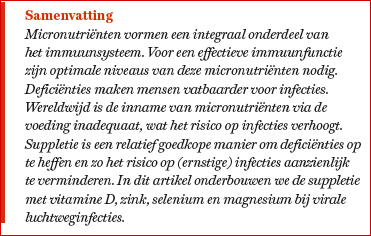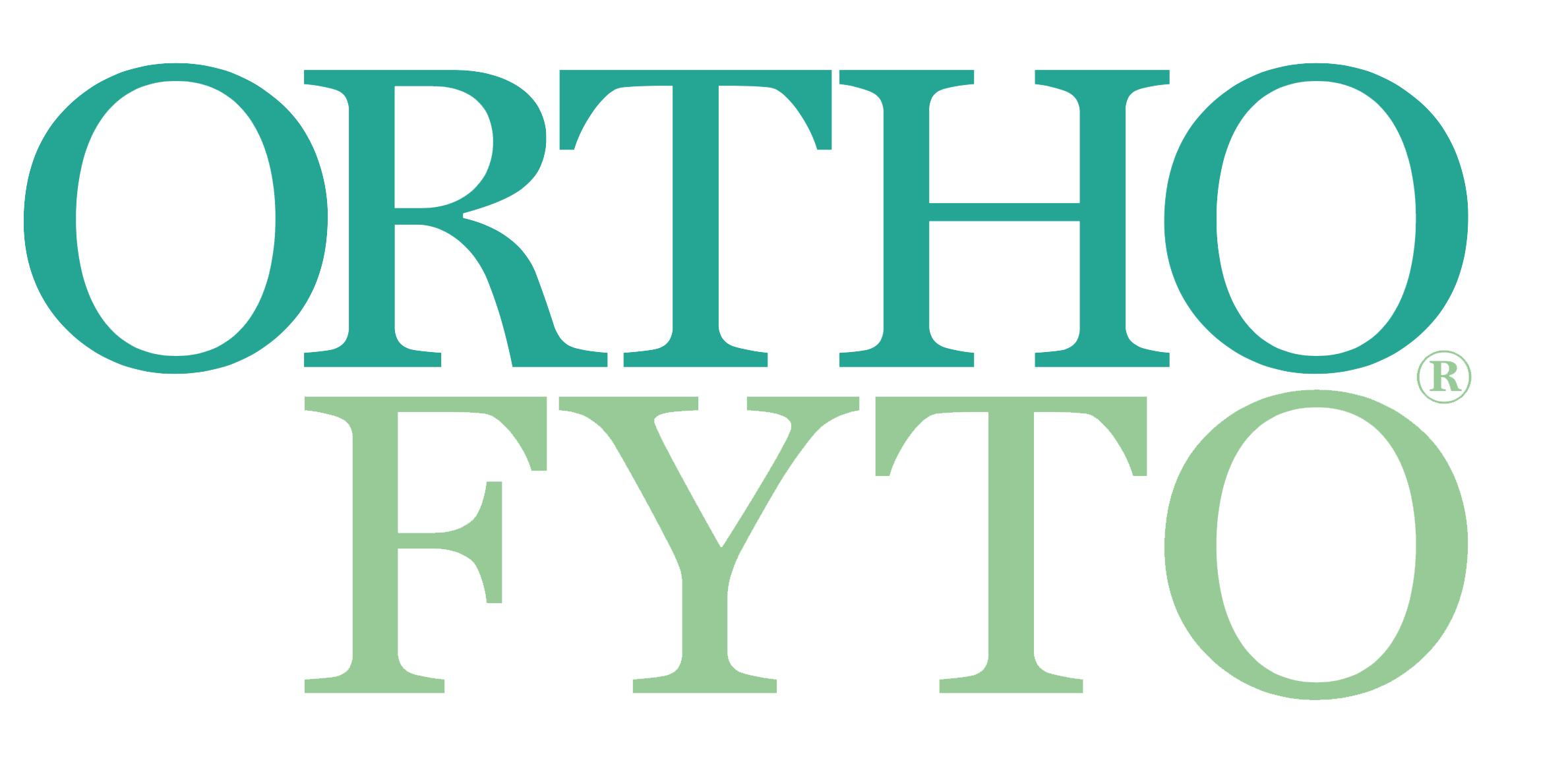Virale luchtweginfecties en suppletie
05 May, 2020
Door: Els Smits
 Vele studies bevestigen dat een inadequate voeding de immuunrespons verzwakt. Tijdens een infectie neemt bovendien de behoefte aan bepaalde micronutriënten aanzienlijk toe. Toch wordt de voedingsstatus van de mens nauwelijks meegenomen als bijdragende factor aan de grootschalige verbreiding van virale infectieziekten.1
Vele studies bevestigen dat een inadequate voeding de immuunrespons verzwakt. Tijdens een infectie neemt bovendien de behoefte aan bepaalde micronutriënten aanzienlijk toe. Toch wordt de voedingsstatus van de mens nauwelijks meegenomen als bijdragende factor aan de grootschalige verbreiding van virale infectieziekten.1
Het immuunsysteem is complex en bestaat uit meerdere lagen: de fysieke en biochemische barrières (inclusief algemene afweerreactie en complementsysteem), de immuuncellen en de antilichamen. Tezamen verzorgen zij de aangeboren en verworven afweer. Diverse micronutriënten hebben een functie in een of meerdere stadia van de immuunrespons. Adequate hoeveelheden van deze micronutriënten zijn essentieel om een goed functioneren van het gehele immuunsysteem te garanderen. Het sterkste bewijs voor een verbetering van de immuunfunctie door suppletie bij luchtweginfecties bestaat er voor vitamine C en D en zink.2 Over vitamine C vindt u meer informatie op pagina 30 t/m 41 van deze editie. Voor de overige genoemde nutriënten volgt hieronder een kort overzicht van in onderzoek aangetoond bewijs.
Na een virale besmetting beperkt een goed functionerend afweersysteem normaliter de symptomen. Voor een effectieve immuunfunctie zijn optimale niveaus van verschillende micronutriënten nodig. Ten aanzien van het actuele Covid-19-risico adviseert de International Society of Orthomoleculair Medicine (ISOM)3 gerichte suppletie ter preventie van de ziekte en verlichting van de symptomen van geïnfecteerden.
Lees het gehele artikel vanaf pagina 34 in OrthoFyto 3/20. Wilt u het gehele artikel als PDF bestand ontvangen? Bestel het dan hier voor € 3,50. Bronvermelding:- Lei Zhang, Yunhui Liu. Potential interventions for novel coronavirus in China: A systematic review. J Med Virol. 2020;92:479–490.
- Gombart AF, Pierre A, Maggini S. A Review of Micronutrients a0nd the Immune System–Working in Harmony to Reduce the Risk of Infection. Nutrients 2020, 12, 236; doi:10.3390/nu12010236
- www.orthomolecular.org/resources
- Grant WB, Lahore H, McDonnell SL, Baggerly CA, French CB, Aliano JL, Bhattoa HP. Evidence that vitamin D supplementation could reduce risk of influenza and COVID-19 infections and deaths. Nutrients 2020, 12, 988;
- C. Zhang, Z. Wu and J.-W. Li et al. The cytokine release syndrome (CRS) of severe COVID-19 and Interleukin-6 receptor (IL-6R) antagonist Tocilizumab may be the key to reduce the mortality, International Journal of Antimicrobial Agents. Available online 29 March 2020, 105954.
- Martineau AR, Jolliffe DA, Hooper RL, Greenberg L, Aloia JF, Bergman P, ... Camargo Jr, CA. Vitamin D supplementation to prevent acute respiratory tract infections: systematic review and meta-analysis of individual participant data. BMJ2017; 356doi:
- Cannell JJ, Vieth R, Umhau JC et al. (2006) Epidemic influenza and vitamin D. Epidemiol Infect. 134:1129-1140.
- Urashima M, Segawa T, Okazaki M et al. (2010) Randomized trial of vitamin D supplementation to prevent seasonal influenza A in schoolchildren. Am J Clin Nutr. 91:1255-60.
- Ginde AA, Mansbach JM, Camargo CA Jr. (2009) Association between serum 25-hydroxyvitamin D level and upper respiratory tract infection in the Third National Health and Nutrition Examination Survey. Arch Intern Med. 169:384-390.
- Das RR, Singh M, Naik SS. (2018) Vitamin D as an adjunct to antibiotics for the treatment of acute childhood pneumonia. Cochrane Database Syst. Rev. 7, CD011597.
- Miri M, Kouchek M, Rahat Dahmardeh A, Sistanizad M. Effect of High-Dose Vitamin D on Duration of Mechanical Ventilation in ICU Patients. Iran J Pharm Res. 2019 Spring;18(2):1067-1072.
- Wimalawansa, S.J. Global epidemic of coronavirus–COVID-19: What we can do to minimize risks. Eur. J. Biomed. Pharm. Sci. 2020, 7, 432–438.
- Alschuler L, Weil A, Horwitz R, Stamets P, Chiasson AM, Crocker R, Maizes V. Integrative Considerations during the COVID-19 pandemic.
- Shankar AH, Prasad AS. Zinc and immune function: The biological basis of altered resistance to infection. Am. J. Clin. Nutr. 1998, 68, 447s–463s.
- Prasad, A. S. (2008, May). Zinc in human health: Effect of zinc on immune cells. Molecular Medicine. The Feinstein Institute for Medical Research.
- Phillips JM, et al. Neurovirulent Murine Coronavirus JHM.SD Uses Cellular Zinc Metalloproteases for Virus Entry and Cell-Cell Fusion. J Virol. 2017;91(8).
- Han YS, Chang GG, Juo CG, Lee HJ, Yeh SH, Hsu JT, Chen X. Papain-like Protease 2 (PLP2) From Severe Acute Respiratory Syndrome Coronavirus (SARS-CoV): Expression, Purification, Characterization, and Inhibition. Biochemistry. 2005;44(30):10349.
- Aggarwal, R.; Sentz, J.; Miller, M.A. Role of zinc administration in prevention of childhood diarrhea and respiratory illnesses: A meta-analysis. Pediatrics. 2007, 119, 1120–1130.
- Fraker PJ, King LE, Laakko T, Vollmer TL. (2000) The dynamic link between the integrity of the immune system and zinc status. J Nutr. 130:1399S-406S.
- Guillin OM, Vindry C, Ohlmann T, Chavatte L. Selenium, selenoproteins and viral infection. Nutrients. 2019;11:2101.
- Harthill M. Review: micronutrient selenium deficiency influences evolution of some viral infectious diseases. Biol Trace Elem Res. 2011; 143:1325‐1336.
- Beck MA, Levander OA, Handy J. (2003) Selenium deficiency and viral infection. J Nutr. 133:1463S-1467S.
- Steinbrenner H, Al-Quraishy S, Dkhil MA et al. (2015) Dietary selenium in adjuvant therapy of viral and bacterial infections. Adv Nutr. 6:73-82.
- Dean C (2017) Magnesium. OMNS,
- Deng X, Song Y, Manson JE, Signorello LB, Zhang SM, Shrubsole MJ, Ness RM, Seidner DL, Dai Q. Magnesium, vitamin D status and mortality: results from US National Health and Nutrition Examination Survey (NHANES) 2001 to 2006 and NHANES III. BMC Medicine 2013. 11:187.
- van Schoor, N., & Lips, P. (2017). Worldwide Vitamin D Status. In Vitamin D: Fourth Edition (Vol. 2, pp. 15–40). Elsevier Inc. ISBN 9780128099636
